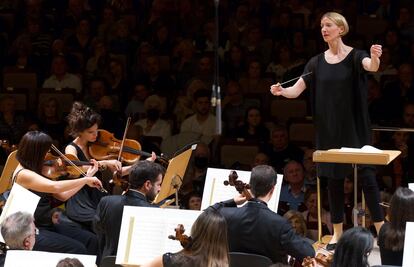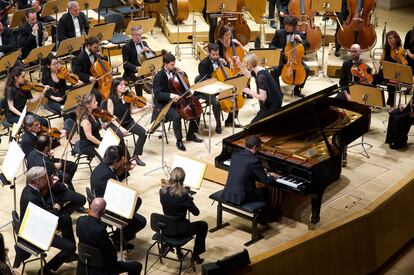Getting an orchestra to speak to us but also sing to us. Joana Mallwitz (Hildesheim, 38 years old) explained last month, in an interview for the German magazine Rondoher artistic project as an orchestra director: “I come from a generation that grew up under the new impulses of the early music movement. I would like to combine this way of playing with all the potential of a modern symphony orchestra: articulation with genuine singable”. He goes on to explain that historically informed interpretation has had more of an impact on oratory than on singing, something he exemplifies with the expression “sound speech” coined by Nikolaus Harnoncourt. She aspires to combine that discursive capacity with the beauty of more traditional phrasing. In other words, he aspires to find the middle ground between Harnoncourt and Karajan.
Few people dedicated to orchestral conducting today are able to explain their aesthetic creed in such a clear way. There are even fewer who make it visible and audible with such authority, as we saw last Friday, October 18, in this young, slender and elegant conductor on the podium of the National Orchestra of Spain, inside a symphony hall of the Madrid Auditorium completely full. There was a lot of expectation for Mallwitz’s Spanish debut, after his successful first season as head of the Konzerthausorchester Berlin, but also after his excellent recording debut on Deutsche Grammophon or the good reviews that garnered his first appearances at the head of the Vienna Philharmonic. and the Amsterdam Concertgebouw.
Mallwitz designed a program very appropriate for the current turbulent times with symphonic works by Prokofiev, Hindemith and Ravel connected by the role of the artist in a society traumatized by war. This is a musical itinerary that she has chosen for almost all of her performances as a guest conductor. He has just conducted it at the head of the Rotterdam Philharmonic, he will do it again in November at the head of the Swedish Radio Symphony and he will repeat it in March for his debut at the head of the Berlin Philharmonic. In Madrid, he added to this program the Beethoven piano concerto most closely linked to that common link: no. 5, popularly known as Emperorand written in 1809 after Napoleon’s siege of Vienna.
The three programmed symphonic works also have a clear link with Mallwitz’s career. Not only did he direct operatic productions of War and peaceProkofiev, and Matías the painterby Hindemith, during his time as musical director of the Nuremberg State Theater (2018-2023), but also The Waltzby Ravel, was the culmination of one of his symphonic concerts in the Bavarian city.
The colorful beginning of the overture War and peaceby Prokofiev, which the conductor marked with a broad and round gesture, extracted from the National Orchestra a true embodiment of heroism in the brass instruments, although she especially made the strings sing her passionate anthem. In any case, the German did not forget to highlight the insistent signs that advance the threat of war and that will disrupt the plot of the opera. Obviously, Prokofiev was based on Tolstoy’s novel of the same name in which he deals with the Napoleonic invasion of Russia, but he did so as a reaction, in 1941, to another invasion: that of the Nazis of the Soviet Union during World War II.
In it emperor concertby Beethoven, we hear a good example of Mallwitz’s aforementioned aesthetic creed. It was an incisive version, full of contrasts and with an exquisite dynamic palette, which the director communicated to the orchestra with powerful corpographies. He found in the pianist Francesco Piemontesi (Locarno, 41 years old) a good traveling companion. The Swiss soloist played with crystalline virtuosity, an exquisite legato and an admirable dynamic range, which especially enhanced the development of the allegro initial. However, his careful and classic version of the slowly a little rough did not finish rising and did not convince in the transition to rondo finale, which was curiously the best of the entire concert and where he dared with some very slight ornament of his own. Piemontesi, who canceled a recital in Valladolid last Sunday due to health problems, did not hesitate to give the Madrid audience a tip. And he finished his performance by underlining his classicist sensitivity with a refined interpretation of the adagio of the Sonata in F major, K. 332by Mozart.

The second part included the two most difficult compositions of the program, but they were the best of the night. Mallwitz did not hesitate to wait almost a minute until he achieved the atmosphere of concentration necessary to address the angels concert that opens the opera Matías the painterby Hindemith, but also his symphony. A 1934 composition, slightly before the opera, written in reaction to the rise to power of the Nazis in Germany. It is a reflection on the role of the artist in society built from a fictional story about the life of Matthias Grünewald, the painter who lived through the German Peasants’ War against the feudal lords, and inspired by the famous Isenheim Altarpiececompleted in 1516.
In the first movement, Mallwitz activated colorism without neglecting his powerful counterpoint. In the second, Gravetaken from the final scene in which the painter faces death, achieved admirable sonic plasticity with the best performance of the woodwind. And in the very difficult final movement, titled The Temptation of Saint Anthonyin which the protagonist is tormented during a dream by the other characters in the opera, the strings led by violinist Valerie Steenken shone as concertmaster and the roundness of metal in the final hallelujah.
The Waltzby Ravel, was an ideal finishing touch. Mallwitz brought out all the bite in this totally expressionist 1920 score by the French composer. A tribute to Johann Strauss Jr., deformed by the composer’s traumatic experiences during the First World War. The initial swirls and the haze of the opening waltz propelled that grotesque and progressive distortion, for which there was admirable work from the percussion, and where the National Orchestra sounded like a cohesive body that exercised its throat and showed its teeth. The concert will be repeated today, Saturday the 19th, and will be broadcast live on Sunday, at 11:30, on Radio Clásica.
National Orchestra of Spain. Symphonic Cycle 04
Works by Prokofiev, Beethoven, Hindemith & Ravel. Francesco Piedmontese (piano). National Orchestra of Spain. Joanna Mallwitz (direction). National Auditorium, Oct. 18-20.

